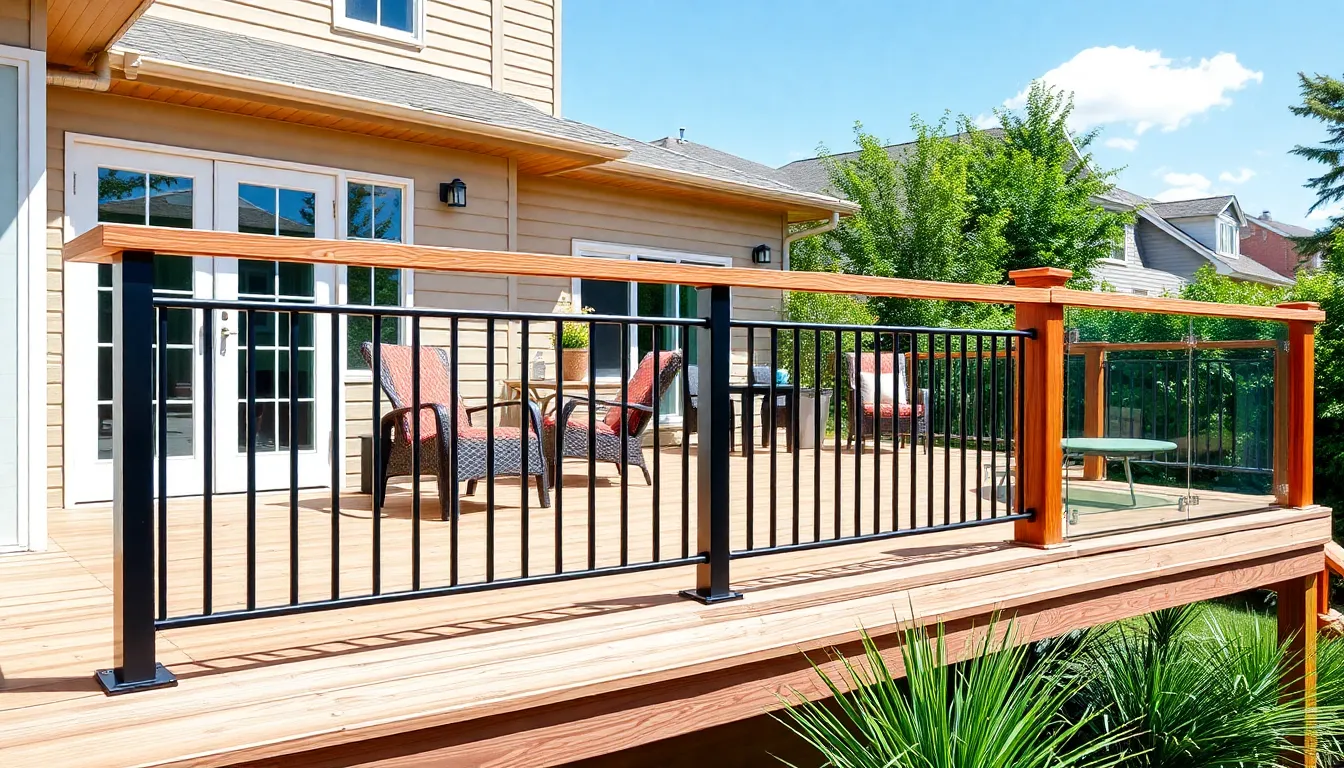Deck railing plays a crucial role in both safety and aesthetics for outdoor spaces. Whether it’s a cozy patio or an expansive deck, the right railing can transform an ordinary area into a stunning retreat. It not only provides essential support but also enhances the overall look of a home, making it a key element in outdoor design.
With a variety of materials and styles available, homeowners can choose railings that suit their personal taste and complement their property’s architecture. From classic wood to modern glass and metal options, the choices are endless. Understanding the benefits and features of different deck railings can help anyone make informed decisions that elevate their outdoor living experience.
Table of Contents
ToggleOverview of Deck Railing
Deck railing serves as a crucial element in residential outdoor spaces, contributing to safety, functionality, and aesthetics. Deck railings create a barrier that prevents accidental falls, particularly in elevated areas. The height and strength of railings play a significant role in ensuring compliance with safety regulations. Heights typically range from 36 to 42 inches, depending on local building codes.
Materials for deck railing vary widely, each with unique advantages.
- Wood: Offers a classic look and warmth, requiring regular maintenance to prevent rot and weathering.
- Metal: Provides durability and modern appeal, often available in aluminum or wrought iron. These metal options withstand harsh weather and require minimal upkeep.
- Glass: Enhances views while providing a contemporary vibe. Glass panels must be tempered for safety and are easier to clean than wood or metal options.
Styles also vary, from traditional balusters to sleek, minimalist designs. Homeowners may select designs that align with their personal taste and complement their specific architectural styles. Various features, such as decorative post caps or integrated lighting, further enhance the visual appeal.
Understanding these elements aids homeowners in making informed decisions, leading to an improved outdoor living experience.
Types of Deck Railing

Homeowners have various options for deck railing, each offering distinct advantages. The choice of material and style significantly influences safety, aesthetics, and maintenance needs.
Wood Deck Railing
Wood deck railing provides a classic and warm look that complements traditional and contemporary designs. Cedar and redwood are popular choices due to their resistance to decay. While wood railings require regular maintenance, such as sealing and staining, their natural beauty appeals to many. Homeowners can choose from a range of styles, including vertical balusters or horizontal slats, enabling customization to suit individual tastes.
Metal Deck Railing
Metal deck railing features durability and low maintenance, making it an excellent option for modern outdoor spaces. Aluminum and wrought iron are common materials, both offering strength and resistance to rust. Metal railings come in various designs, including baluster and cable styles, enabling sleek and minimalist aesthetics. Their structural integrity ensures safety without compromising visual appeal, which is crucial for elevated decks.
Glass Deck Railing
Glass deck railing enhances outdoor views while maintaining safety and elegance. Tempered glass panels provide security without obstructing sightlines, making them ideal for homes with scenic surroundings. This type of railing requires periodic cleaning to maintain clarity but offers a contemporary look that complements a variety of architectural styles. Framed or frameless designs are available, allowing homeowners to achieve the desired balance between transparency and structure.
Benefits of Installing Deck Railing
Deck railing offers numerous advantages, primarily enhancing safety and aesthetic appeal in outdoor spaces.
Safety Features
Deck railings act as a crucial safety barrier, particularly in elevated areas. They prevent accidental falls, ensuring the safety of children and pets. Most municipalities enforce safety regulations that mandate a railing height between 36 and 42 inches. Properly installed railings meet these standards, providing peace of mind for homeowners. Additionally, specific materials like metal and glass utilize tempered features, improving structural integrity and reducing the risk of injury. Safety benefits make deck railings essential for any elevated outdoor structure.
Aesthetic Appeal
Deck railings significantly enhance the visual charm of an outdoor area. Homeowners can select from a variety of styles—traditional, modern, or minimalist—to complement their property’s architecture. Wood railings deliver a classic, warm presence, while metal options like aluminum or wrought iron offer sleek, contemporary looks. Glass railings maximize views, creating an unobstructed sightline that merges the indoor and outdoor environments. Decorative elements such as post caps and integrated lighting can further elevate the style, turning a functional safety feature into a design highlight. The aesthetic benefits ensure that deck railings serve both practical and visual purposes, enriching outdoor experiences.
Factors to Consider When Choosing Deck Railing
Selecting the right deck railing requires careful consideration of various factors. Key elements include material durability and maintenance requirements, each contributing to the overall longevity and aesthetic of the railing.
Material Durability
Material durability directly impacts the lifespan and performance of deck railings.
- Wood: Offers a classic aesthetic, but potential susceptibility to rot and insect damage necessitates regular treatment. Lifespan varies between 10 to 30 years, depending on care and climate.
- Metal: Aluminum and steel resist rust and corrosion. Aluminum typically lasts over 30 years, while galvanized steel offers a similar lifespan, especially in protected environments.
- Glass: Provides an unobstructed view and uses tempered safety glass for strength. It remains functional for 20 to 30 years, provided it faces minimal impact and adheres to safety standards.
Maintenance Requirements
Maintenance requirements determine the effort needed to keep deck railings in optimal condition.
- Wood: Requires staining or sealing every 1 to 3 years to prevent decay and maintain appearance. Regular inspections help identify issues early.
- Metal: Typically low-maintenance, needing occasional cleaning to prevent dirt buildup. Most aluminum and steel options do not require repainting, reducing long-term care.
- Glass: Demands minimal upkeep aside from periodic cleaning to remove water spots and fingerprints. Ensure proper sealing to maintain structural integrity in wet conditions.
Popular Deck Railing Designs
Homeowners often choose deck railing designs based on aesthetics, functionality, and material properties. Various popular designs incorporate unique features and styles tailored to individual preferences.
Traditional Baluster Railing
Traditional baluster railing consists of vertical posts spaced evenly along the railing. This style provides a classic look while ensuring safety. Balusters can be crafted from wood or metal, allowing for customization in color and finish.
Modern Cable Railing
Modern cable railing uses horizontal stainless steel cables stretched between posts. This design offers a sleek, minimalist look while maximizing visibility. It suits contemporary homes and provides ample airflow and light.
Glass Panel Railing
Glass panel railing features clear or frosted panels held in place by metal or wood frames. This design enhances views while maintaining safety. Glass materials also contribute to a modern aesthetic and require low maintenance.
Composite Railing
Composite railing combines wood fibers and plastic, offering durability and a wood-like appearance. This design resists fading, cracking, and insects, making it a practical choice for many homeowners. It comes in various colors and styles to complement different architectural designs.
Vinyl Railing
Vinyl railing provides a low-maintenance option that mimics the look of wood or metal. It resists rotting and peeling, ensuring durability in various weather conditions. Vinyl options often come in multiple colors, enhancing customization.
Semi-Private Railing
Semi-private railing includes designs with solid panels interspersed with open sections. This style balances visibility and privacy, making it suitable for properties where seclusion is a priority. Options include latticework or decorative cutouts that add style.
Custom Railing Designs
Custom railing designs allow homeowners to create unique features that reflect their personalities and preferences. Options can include intricate woodwork, artistic metal designs, or bespoke glass shapes. Custom railings often serve as focal points that enhance the overall aesthetic of outdoor spaces.
Vertical Slat Railing
Vertical slat railing uses vertically aligned panels or slats. This design offers a unique visual appeal and can provide varying degrees of privacy. Slats can be spaced for visibility or closer together for a more secluded feel.
These popular deck railing designs each offer distinct benefits, enhancing both the safety and aesthetic appeal of outdoor spaces. Homeowners often select a design that aligns with their personal style and functional needs.
Choosing the right deck railing is essential for creating a safe and inviting outdoor space. With a variety of materials and styles available, homeowners can find options that not only meet safety regulations but also enhance the aesthetic appeal of their property. Whether opting for the classic charm of wood or the sleek modernity of glass, each choice brings unique benefits.
Investing in quality deck railing ensures peace of mind while enjoying outdoor activities. By carefully considering design, material, and maintenance needs, homeowners can achieve a perfect balance of safety and style. Ultimately, the right railing transforms a simple deck into a beautiful and secure retreat.


